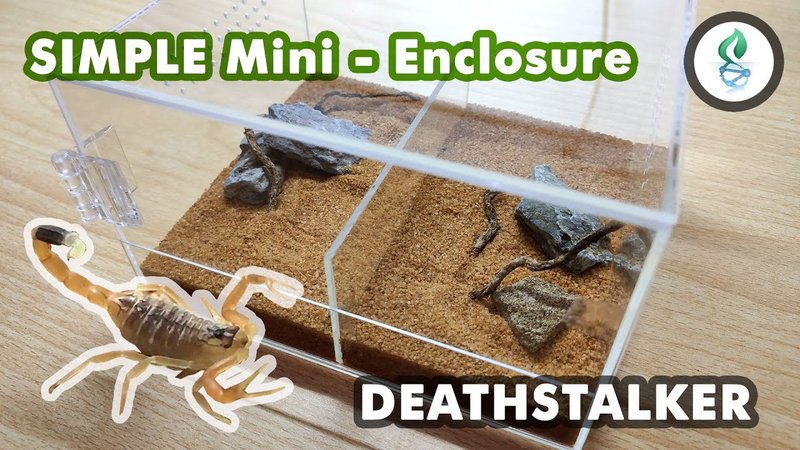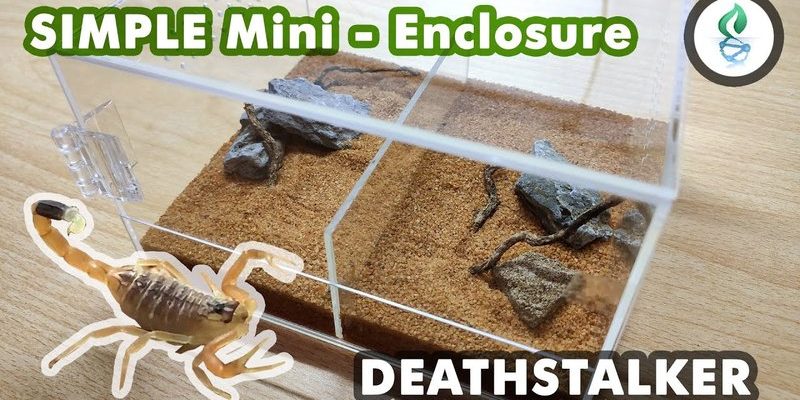
When it comes to their enclosures, there’s no one-size-fits-all solution. It’s important to consider factors like temperature, humidity, substrate, and decor. Think of it this way: you wouldn’t want to live in a place that’s too hot, too cold, or without any personal touches, right? In this guide, we’ll walk through everything you need to know to create the best enclosure setup for your Deathstalker Scorpion, ensuring a thriving environment for your spiky little friend.
Choosing the Right Enclosure Size
Selecting the right enclosure size is essential for the well-being of your Deathstalker Scorpion. While these scorpions don’t require a massive space, they do need enough room to roam and explore. A general rule of thumb is to start with a terrarium that’s at least 10 to 20 gallons. This size allows for ample space for your scorpion to climb, burrow, and engage in natural behaviors.
Here’s why size matters: a smaller enclosure can lead to stress, which may affect your scorpion’s health. Think of it like living in an apartment with too many roommates—there’s just not enough room to chill out. Additionally, a larger enclosure can give you more flexibility in creating diverse habitats, with hiding spots, climbing areas, and substrates.
Make sure to secure the top of the enclosure with a fine mesh or a tight-fitting lid to prevent any great escapes. Deathstalker Scorpions are nimble little critters, and they can be surprisingly good at finding their way out of spaces that seem secure.
Managing Temperature and Humidity
Creating the right temperature and humidity levels is crucial for your Deathstalker Scorpion’s health. These scorpions thrive in warm, dry environments, typically found in their native habitats in North Africa and the Middle East. Your enclosure should have a daytime temperature ranging between 85°F and 95°F. You can achieve this by using a heat mat or ceramic heat emitter placed on one side of the terrarium, creating a warm gradient.
Don’t forget about humidity! Deathstalker Scorpions prefer a lower humidity level, around 40-60%. Too much moisture can lead to health issues like mold or even respiratory problems. To maintain this balance, you could use a hygrometer to monitor humidity levels and adjust them by lightly misting the enclosure when needed. But here’s the thing—be careful not to overdo it. You’re not trying to create a rainforest here!
Plus, the temperature gradient is a great way to encourage your scorpion to move around, explore, and find their favorite hot spot. Providing both warm and cooler areas helps mimic their natural environment, making them feel more at home.
Choosing the Right Substrate
Substrate selection plays an essential role in your Deathstalker Scorpion’s enclosure. The substrate is the ground covering inside the terrarium, and it should allow for digging and burrowing. A mix of sand and coconut fiber is a popular choice, as it creates a natural tunnel-like environment that scorpions love.
Aim for at least 2 to 3 inches of substrate depth. This gives your scorpion enough material to burrow and explore, satisfying their instinctual behaviors. Just think of it as creating a mini desert landscape within your enclosure. You can use materials like excavator clay, which hardens when wet, allowing for tunneling and proper structure.
Don’t forget to spot clean regularly! Deathstalkers can be messy eaters, and keeping the enclosure tidy will help maintain the right conditions and prevent any odor buildup. A clean environment is a happy environment.
Creating Hiding Spots and Climbing Areas
Deathstalker Scorpions are experts at hiding, so providing adequate hiding spots is crucial for their sense of security. In the wild, they often take shelter under rocks, bark, or other natural debris. You can mimic this by adding pieces of slate, driftwood, or commercially available hides to your enclosure.
Placing these hides strategically throughout the enclosure encourages your scorpion to explore and feel safe. Think of it as setting up cozy cafes in their little neighborhood—some places to hang out, some to chill! Additionally, incorporating vertical elements, like branches or cork bark, offers climbing opportunities. Scorpions are natural climbers, so giving them the chance to scale surfaces not only enhances their space but also contributes to their physical health.
Just remember to ensure any decor you add is free of sharp edges, as this can harm your scorpion. It’s all about creating a safe, stimulating environment.
Water and Feeding Requirements
Keeping your Deathstalker Scorpion well-fed and hydrated is key to a successful enclosure setup. While they can get moisture from their food, it’s still a good idea to have a shallow water dish available. You can use a small bowl or a bottle cap filled with water, making sure it’s shallow enough for your scorpion to access easily.
When it comes to feeding, these little guys are carnivorous and thrive on a diet of insects. Crickets, roaches, and mealworms are great options. Aim to feed adult scorpions every 1-2 weeks, while younger ones may need more frequent feedings—about every few days. Just keep an eye on leftover food; removing uneaten insects will help maintain a clean environment and prevent stress.
Honestly, it’s fascinating to watch them hunt. They’re like tiny, spiky ninjas! You might even consider supplementing their diet with calcium dust to ensure they’re getting enough nutrients, especially if breeding is in your future plans.
Lighting Considerations
Lighting is another important aspect of creating the best enclosure setup for your Deathstalker Scorpion. While they prefer darkness, providing a light cycle can help mimic their natural habitat. You don’t need a bright light—just a gentle source that allows you to observe them better without stressing them out.
Using a low-intensity UVB light can benefit your scorpion by helping with calcium absorption, but it’s essential to provide a shaded area in the enclosure. This way, your scorpion can escape the light whenever they feel the need. Think of it as offering them a comfy blanket to hide under!
Keep the light on for about 12 hours a day to establish a healthy day-night cycle. This helps regulate their behavior, digestion, and overall well-being.
Regular Maintenance and Observations
Finally, regular maintenance and observing your scorpion’s behavior are crucial to keeping its enclosure in top shape. Consistently check temperature and humidity levels, making adjustments as necessary. Spot cleaning should be a part of your routine—removing waste and uneaten food every few days keeps the environment healthy.
Pay attention to your scorpion’s behavior as well. Are they active and roaming, or do they seem lethargic? Changes in activity can indicate health issues or stress in the enclosure. Keeping a keen eye on your pet helps you catch potential problems early.
By taking the time to observe and maintain the enclosure, you’re not just providing a home—you’re creating a thriving environment that allows your Deathstalker Scorpion to flourish.
In summary, creating the best enclosure setup for your Deathstalker Scorpion involves careful planning and attention to detail. From choosing the right size and substrate to managing temperature and humidity, every decision contributes to your scorpion’s health and happiness. So, roll up your sleeves, channel your inner decorator, and get ready to provide a fantastic new home for your scaly friend!

